MISQUarterly
Executive
iT projeCT managemenT: infamous
failures, ClassiC misTakes, and besT
praCTiCes1
IT Project Management
R. Ryan Nelson
University of Virginia
MISQE is
sponsored by:
Executive Summary
In recent years, IT project failures have received a great deal of attention in the press as
well as the boardroom. In an attempt to avoid disasters going forward, many organizations
are now learning from the past by conducting retrospectives—that is, project postmortems
or post-implementation reviews. While each individual retrospective tells a unique story
and contributes to organizational learning, even more insight can be gained by examining
multiple retrospectives across a variety of organizations over time. This research
aggregates the knowledge gained from 99 retrospectives conducted in 74 organizations
over the past seven years. It uses the findings to reveal the most common mistakes and
suggest best practices for more effective project management.2
InFAMOuS FAILurES
“Insanity: doing the same thing over and over again and expecting different results.”
— Albert Einstein
If failure teaches more than success, and if we are to believe the frequently quoted
statistic that two out of three IT projects fail,3 then the IT profession must be
developing an army of brilliant project managers. Yet, although some project
managers are undoubtedly learning from experience, the failure rate does not seem
to be decreasing. This lack of statistical improvement may be due to the rising size
and complexity of projects, the increasing dispersion of development teams, and the
reluctance of many organizations to perform project retrospectives.4 There continues
to be a seemingly endless stream of spectacular IT project failures. No wonder
managers want to know what went wrong in the hopes that they can avoid similar
outcomes going forward.
Figure 1 contains brief descriptions of 10 of the most infamous IT project failures.
These 10 represent the tip of the iceberg. They were chosen because they are the most
heavily cited5 and because their magnitude is so large. Each one reported losses over
$100 million. Other than size, these projects seem to have little in common. One-half
come from the public sector, representing billions of dollars in wasted taxpayer dollars
and lost services, and the other half come from the private sector, representing billions
of dollars in added costs, lost revenues, and lost jobs.
Jeanne Ross was the Senior Editor, Keri Pearlson and Joseph Rottman were the Editorial Board Members for
The author would like to thank Jeanne Ross, anonymous members of the editorial board, Barbara McNurlin,
The Standish Group reports that roughly two out of three IT projects are considered to be failures (suffering
1
this article for this article.
2
and my colleague Barb Wixom, for their comments and suggestions for improving this article.
3
from total failure, cost overruns, time overruns, or a rollout with fewer features or functions than promised).
4
Just 13% of the Gartner Group’s clients conduct such reviews, says Joseph Stage, a consultant at the
Stamford, Connecticut-based firm. Quoted in Hoffman, T. “After the Fact: How to Find Out If Your IT Project
Made the Grade,” Computerworld, July 11, 2005.
Glass, R. Software Runaways: Lessons Learned from Massive Software Project Failures, 1997; Yourdon, E.
5
Death March: The Complete Software Developer’s Guide to Surviving ‘Mission Impossible’ Projects, 1999. “To
Hell and Back: CIOs Reveal the Projects That Did Not Kill Them and Made Them Stronger,” CIO Magazine,
December 1, 1998. “Top 10 Corporate Information Technology Failures,” Computerworld:
http://www.computerworld.com/computerworld/records/images/pdf/44NfailChart.pdf; McDougall, P. “8
Expensive IT Blunders,” InformationWeek, October 16, 2006.
© 2007 University of Minnesota
MIS Quarterly Executive Vol. 6 No. 2 / June 2007 67
�
Nelson / IT Project Management
Figure 1: Infamous IT Project Failures
Internal Revenue Service
PROJECT: Business Systems Modernization; Launched in 1999 to upgrade
the agency’s IT infrastructure and more than 100 business applications.
PROJECT: “Trilogy;” Four-year, $500M overhaul of the FBI’s antiquated
computer system.
PROJECT: Advanced Automation System (AAS); FAA’s effort to modernize
the nation’s air traffic control system.
WHAT HAPPENED? By assembling a star-studded team of vendors, the IRS thought its $8 billion
modernization project would manage itself. The IRS thought wrong. As a result, the agency’s ability to collect
revenue, conduct audits, and go after tax evaders was severely compromised. This case study illustrates what
can go wrong when a complex project overwhelms the management capabilities of both vendor and client.
Some consider it to be the most expensive systems development “fiasco” in history, with delays costing the U.S.
Treasury tens of billions of dollars per year.
Source: http://www.cio.com/archive/040104/irs.html.
Federal Aviation
Administration
WHAT HAPPENED? AAS was originally estimated to cost $2.5 billion with a completion date of 1996.
The program, however, experienced numerous delays and cost overruns, which were blamed on both the
FAA and the primary contractor, IBM. According to the General Accounting Office, almost $1.5 billion of
the $2.6 billion spent on AAS was completely wasted. One participant remarked, “It may have been the
greatest failure in the history of organized work.”
Source: http://www.baselinemag.com/article2/0,1540,794112,00.asp.
Federal Bureau of
Investigation
WHAT HAPPENED? Requirements were ill-defined from the beginning and changed dramatically after 9/11
(agency mission switched from criminal to intelligence focus) thus creating a strained relationship between the
FBI and its primary contractor, SAIC. As Senator Patrick Leahy (D-Vt.) stated, “This project has been a train
wreck in slow motion, at a cost of $170M to American taxpayers and an unknown cost to public safety.”
Sources: http://www.cio.com/archive/061505/gmen.html,
http://www.npr.org/templates/story/story.php?storyId=4283204,
http://www.washingtonpost.com/wp-dyn/content/article/2005/06/05/AR2005060501213.html.
McDonalds
WHAT HAPPENED? Conceived in January 2001, Innovate was the most expensive (planned to spend $1 billion
over five years) and intensive IT project in company history. Eventually, executives in company headquarters
would have been able to see how soda dispensers and frying machines in every store were performing, at any
moment. After two years and $170M, the fast food giant threw in the towel.
Source: http://www.baselinemag.com/article2/0,3959,1173624,00.asp.
Denver International
Airport
WHAT HAPPENED? It took 10 years and at least $600 million to figure out big muscles, not computers, can
best move baggage. The baggage system, designed and built by BAE Automated Systems Inc., launched, chewed
up, and spit out bags so often that it became known as the “baggage system from hell.” In 1994 and 1995, the
baggage system kept Denver’s new airport from opening. When it finally did open, the baggage system didn’t.
It was such a colossal failure that every airline except United Airlines refused to use it. And now, finally and
miserably, even United is throwing in the towel.
Sources: http://www.msnbc.msn.com/id/8975649/; BAE Automated Systems (A): Denver International
Airport Baggage-Handling System, Harvard Business School Case #9-396-311, November 6, 1996;
http://www.computerworld.com/managementtopics/management/project/story/0,10801,102405,00.
html?source=NLT_AM&nid=102405.
PROJECT: “Innovate;” Digital network for creating a real-time enterprise.
PROJECT: Baggage-handling system.
68 MIS Quarterly Executive Vol. 6 No. 2 / June 2007
© 2007 University of Minnesota
�
IT Project Management
PROJECT: “Confirm;” Reservation system for hotel and rental car bookings.
Figure 1: Infamous IT Project Failures
AMR Corp., Budget
Rent A Car Corp.,
Hilton Hotels Corp.,
Marriott International Inc.
WHAT HAPPENED? After four years and $125 million in development, the project crumbled in 1992 when it
became clear that Confirm would miss its deadline by as much as two years. AMR sued its three partners for
breach of contract, citing mismanagement and fickle goals. Marriott countersued, accusing AMR of botching
the project and covering it up. Both suits were later settled for undisclosed terms. Confirm died and AMR took a
$109 million write-off.
Sources: http://sunset.usc.edu/classes/cs510_2004/notes/confirm.pdf
http://www.computerworld.com/computerworld/records/images/pdf/44NfailChart.pdf
Bank of America
PROJECT: “MasterNet;” Trust accounting system.
WHAT HAPPENED? In February 1988, hardware problems caused the Bank of America (BofA) to lose
control of several billion dollars of trust accounts. All the money was eventually found in the system, but all
255 people—i.e., the entire Trust Department—were fired, as all the depositors withdrew their money. This is a
classic case study on the need for risk assessment, including people, process, and technology-related risk. BofA
spent $60M to fix the $20M project before deciding to abandon it altogether. BofA fell from being the largest
bank in the world to No. 29.
Source: http://sunset.usc.edu/classes/cs510_2001/notes/masternet.pdf.
KMart
WHAT HAPPENED? To better compete with its rival, Wal-Mart Corp., in Bentonville, Ark., retailer Kmart
Corp., in Troy, Mich., launched a $1.4 billion IT modernization effort in 2000 aimed at linking its sales,
marketing, supply, and logistics systems. But Wal-Mart proved too formidable, and 18 months later, cash-
strapped Kmart cut back on modernization, writing off the $130 million it had already invested in IT. Four
months later, it declared bankruptcy.
Source: http://www.spectrum.ieee.org/sep05/1685.
London Stock Exchange
WHAT HAPPENED? In early 1993, the London Stock Exchange abandoned the development of Taurus after
more than 10 years of development effort had been wasted. The Taurus project manager estimates that, when the
project was abandoned, it had cost the City of London over £800 million. Its original budget was slightly above
£6 million. Taurus was 11 years late and 13,200 percent over budget without any viable solution in sight.
Source: http://www.it-cortex.com/Examples_f.htm.
Nike
WHAT HAPPENED? Nike spent $400 million to overhaul its supply chain infrastructure, installing ERP, CRM,
and SCM—the full complement of analyst-blessed integrated enterprise software. Post-implementation (3rd
quarter, 2000), the Beaverton, Ore.-based sneaker maker saw profits drop by $100 million, thanks, in part, to a
major inventory glitch (it over-produced some shoe models and under-produced others). “This is what I get for
our $400 million?” said CEO Phil Knight.
Source: http://www.cio.com/archive/081502/roi.html.
PROJECT: “Taurus;” Paperless share settlement system.
PROJECT: IT systems modernization.
PROJECT: Integrated enterprise software.
The postmortem in each case contains clues as to what
went wrong. While some of the projects experienced
contractor failure (IRS, FAA, FBI), others cited poor
requirements determination (FAA, FBI), ineffective
stakeholder management (Denver Airport), research-
oriented development (McDonalds), poor estimation
(AMR Corp.), insufficient risk management (BofA),
and a host of other issues. A key objective in each
© 2007 University of Minnesota
MIS Quarterly Executive Vol. 6 No. 2 / June 2007 69
�
Nelson / IT Project Management
postmortem should be to perform a careful analysis
of what went right, what went wrong, and make
recommendations
that might help future project
managers avoid ending up in a similar position.
track record of other
The United Kingdom’s National Health Service
(NHS) is a prime example of an organization that
has not learned from the mistakes of others. Despite
the disastrous
large-scale
modernization projects (by the U.S. IRS, FAA, and
FBI), the U.K.’s NHS elected to undertake a massive
IT modernization project of its own.6 The result is
possibly the biggest and most complex technology
project in the world and one that critics, including two
Members of Parliament, worry may be one of the great
IT disasters in the making. The project was initially
budgeted at close to $12 billion. That figure is now
double ($24 billion), according to the U.K. National
Audit Office (NAO), the country’s oversight agency.
In addition, the project is two years behind schedule,
giving Boston’s Big Dig7 a run for its money as the
most infamous project failure of all time!
The emerging story in this case seems to be a
familiar one: contractor management issues. In fact,
more than a dozen vendors are working on the NHS
modernization, creating a “technological Tower of
Babel,” and significantly hurting the bottom line
of numerous companies. For example, Accenture
dropped out in September 2006, handing its share of
the contract to Computer Sciences Corporation, while
setting aside $450 million to cover losses. Another
main contractor, heath care applications maker iSoft, is
on the verge of bankruptcy because of losses incurred
from delays in deployment. Indeed, a great deal of
time and money can be saved if we can learn from
past experiences and alter our management practices
going forward.
Initiated in 2002, the National Program for Information Technology
6
(NPfIT) is a 10-year project to build new computer systems that are to
connect more than 100,000 doctors, 380,000 nurses, and 50,000 other
health-care professionals; allow for the electronic storage and retrieval
of patient medical records; permit patients to set up appointments via
their computers; and let doctors electronically transmit prescriptions to
local pharmacies. For more information, see: http://www.baselinemag.
com/article2/0,1540,2055085,00.asp and McDougall, op. cit. 2006.
7
“Big Dig” is the unofficial name of the Central Artery/Tunnel
Project (CA/T). Based in the heart of Boston, MA, it is the most
expensive highway project in America. Although the project was
estimated at $2.8 billion in 1985, as of 2006, over $14.6 billion had
been spent in federal and state tax money. The project has incurred
criminal arrests, escalating costs, death, leaks, poor execution, and
use of substandard materials. The Massachusetts Attorney General is
demanding that contractors refund taxpayers $108 million for “shoddy
work.” http://wikipedia.org—retrieved on May 23, 2007.
CLASSIC MISTAKES
“Some ineffective [project management] practices
have been chosen so often, by so many people, with
such predictable, bad results that they deserve to be
called ‘classic mistakes.’”
— Steve McConnell, author of Code Complete and
Rapid Development
After studying the infamous failures described above,
it becomes apparent that failure is seldom a result
of chance. Instead, it is rooted in one, or a series
of, misstep(s) by project managers. As McConnell
suggests, we tend to make some mistakes more
often than others. In some cases, these mistakes
have a seductive appeal. Faced with a project that is
behind schedule? Add more people! Want to speed
up development? Cut testing! A new version of
the operating system becomes available during the
project? Time for an upgrade! Is one of your key
contributors aggravating the rest of the team? Wait
until the end of the project to fire him!
In his 1996 book, Rapid Development,8 Steve
McConnell enumerates three dozen classic mistakes,
grouped into the four categories of people, process,
product, and technology. The four categories are
briefly described here:
People. Research on IT human capital issues has been
steadily accumulating for over 30 years.9 Over this
time, a number of interesting findings have surfaced,
including the following four:
•
•
Undermined motivation probably has a larger
effect on productivity and quality than any other
factor.10
After motivation, the largest influencer of
productivity has probably been either
the
individual capabilities of the team members
or the working relationships among the team
members.11
McConnell, S. Rapid Development, Microsoft Press, 1996. Chapter
8
3 provides an excellent description of each mistake and category.
9
See for example: Sackman, H., Erikson, W.J., and Grant, E.E.
“Exploratory Experimental Studies Comparing Online and Offline
Programming Performance,” Communications of the ACM, (11:1),
January 1968, pp. 3-11; DeMarco, T., and Kister, T. Peopleware:
Productive Projects and Teams, Dorset House, NY, 1987; Melik, R. The
Rise of the Project Workforce: Managing People and Projects in a Flat
World, Wiley, 2007.
10
See: Boehm, B. “An Experiment in Small-Scale Application
Software Engineering,” IEEE Transactions on Software Engineering
(SE7: 5), September 1981, pp. 482-494.
11
See: Lakhanpal, B. “Understanding the Factors Influencing the
Performance of Software Development Groups: An Exploratory Group-
70 MIS Quarterly Executive Vol. 6 No. 2 / June 2007
© 2007 University of Minnesota
�
•
•
The most common complaint
team
members have about their leaders is failure to
take action to deal with a problem employee.12
that
Perhaps the most classic mistake is adding
people to a late project. When a project
is behind, adding people can
take more
productivity away from
team
members than it adds through the new ones.
Fred Brooks likened adding people to a late
project to pouring gasoline on a fire.13
the existing
to
it applies
Process. Process, as
IT project
management, includes both management processes
and technical methodologies. It is actually easier
to assess the effect of process on project success
than to assess the effect of people on success. The
Software Engineering
the Project
Management Institute have both done a great deal of
work documenting and publicizing effective project
management processes. On the flipside, common
ineffective practices include:
Institute and
•
•
Wasted time in the “fuzzy front end”—the time
before a project starts, the time normally spent
in the approval and budgeting process.14 It’s
not uncommon for a project to spend months
in the fuzzy front end, due to an ineffective
governance process, and then to come out of
the gates with an aggressive schedule. It’s much
easier to save a few weeks or months in the
fuzzy front end than to compress a development
schedule by the same amount.
schedules
The human tendency to underestimate and
produce overly optimistic
sets
up a project for failure by underscoping
it, undermining
and
shortchanging
determination
and/or quality assurance, among other things.15
Poor estimation also puts excessive pressure
on team members, leading to lower morale and
productivity.
effective planning,
requirements
•
Insufficient risk management—that is, the failure
to proactively assess and control the things that
See: Larson, C., and LaFasto, F. Teamwork: What Must Go Right,
Brooks, F. The Mythical Man-Month, Addison-Wesley, Reading,
level Analysis,” Information and Software Technology (35:8), 1993, pp.
468-474.
12
What Can Go Wrong, Sage, Newberry Park, CA, 1989.
13
MA, 1975.
14 Khurana, A., and Rosenthal, S.R. “Integrating the Fuzzy Front
End of New Product Development,” Sloan Management Review (38:2),
Winter 1997, pp. 103-120.
15
Microsoft Press, 2006.
McConnell, S. Software Estimation: Demystifying the Black Art,
IT Project Management
might go wrong with a project. Common risks
today include lack of sponsorship, changes in
stakeholder buy-in, scope creep, and contractor
failure.
•
Accompanying the rise in outsourcing and
offshoring has been a rise in the number of
cases of contractor failure.16 Risks such as
unstable requirements or ill-defined interfaces
can magnify when you bring a contractor into
the picture.
Product. Along with time and cost, the product
dimension represents one of the fundamental trade-offs
associated with virtually all projects. Product size is
the largest contributor to project schedule, giving rise
to such heuristics as the 80/20 rule. Following closely
behind is product characteristics, where ambitious
goals for performance, robustness, and reliability can
soon drive a project toward failure – as in the case
of the FAA’s modernization effort, where the goal
was 99.99999% reliability, which is referred to as
“the seven nines.” Common product-related mistakes
include:
•
•
•
•
Requirements gold-plating—including
unnecessary product size and/or characteristics
on the front end.
Feature creep. Even
if you successfully
avoid requirements gold-plating, the average
project experiences about a +25% change in
requirements over its lifetime.17
gold-plating. Developers
Developer
are
fascinated with new
technology and are
sometimes anxious to try out new features,
whether or not they are required in the product.
development.
Seymour
Research-oriented
Cray, the designer of the Cray supercomputers,
once said that he does not attempt to exceed
engineering limits in more than two areas at
a time because the risk of failure is too high.
Many IT projects could learn a lesson from
Cray, including a number of the infamous
failures cited above
(McDonalds, Denver
International Airport, and the FAA).
Technology. The final category of classic mistakes
has to do with the use and misuse of modern
technology. For example:
Willcocks, L., and Lacity, M. Global Sourcing of Business and IT
Jones, C. Assessment and Control of Software Risks, Yourdon
16
Services, Palgrave Macmillan, 2006.
17
Press Series, 1994.
© 2007 University of Minnesota
MIS Quarterly Executive Vol. 6 No. 2 / June 2007 71
�
Nelson / IT Project Management
•
•
•
Silver-bullet syndrome. When project teams
latch onto a single new practice or new
technology and expect it to solve their problems,
they are inevitably disappointed (despite the
advertised benefits). Past examples included
fourth generation languages, computer-aided
software engineering tools, and object-oriented
development. Contemporary examples include
offshoring, radio-frequency identification, and
extreme programming.
Overestimated savings from new
tools or
methods. Organizations seldom improve their
productivity in giant leaps, no matter how many
new tools or methods they adopt or how good
they are. Benefits of new practices are partially
offset by the learning curves associated with
them, and learning to use new practices to their
maximum advantage takes time. New practices
also entail new risks, which people likely
discover only by using them.
Switching tools in the middle of a project.
It occasionally makes sense
to upgrade
incrementally within the same product line,
from version 3 to version 3.1 or sometimes even
to version 4. But the learning curve, rework,
and inevitable mistakes made with a totally new
tool usually cancel out any benefits when you’re
in the middle of a project. (Note: this was a key
issue in Bank of America’s infamous failure.)
Project managers need to closely examine past
mistakes such as these, understand which are more
common than others, and search for patterns that
might help them avoid repeating the same mistakes in
the future. To this end, the following is a description
of a research study of the lessons learned from 99 IT
projects.
A META-rETrOSPECTIVE OF 99
IT PrOjECTS
Since summer 1999, the University of Virginia has
delivered a Master of Science in the Management of
Information Technology (MS MIT) degree program in
an executive format to working professionals. During
that time, a total of 502 working professionals, each
with an average of over 10 years of experience and
direct involvement with at least one major IT project,
have participated in the program. In partial fulfillment
of program requirements, participants work in teams
to conduct retrospectives of recently completed IT
projects.
Thus far, a total of 99 retrospectives have been
conducted in 74 different organizations. The projects
studied have ranged from relatively small (several
hundred thousand dollars) internally built applications
to very large (multi-billion dollar) mission-critical
applications involving multiple external providers. All
502 participants were instructed on how to conduct
effective retrospectives and given a framework for
assessing each of the following:
•
•
•
•
•
Project context and description
Project timeline
Lessons learned—an evaluation of what went
right and what went wrong during the project,
including the presence of 36 “classic mistakes.”
Recommendations for the future
Evaluation of success/failure
When viewed individually, each retrospective tells
a unique story and provides a rich understanding
of the project management practices used within a
specific context during a specific timeframe. However,
when viewed as a whole, the collection provides
an opportunity to understand project management
practices at a macro level (i.e., a “meta-retrospective”)
and generate findings that can be generalized across a
wide spectrum of applications and organizations. For
example, the analysis of projects completed through
2005 provided a comprehensive view of the major
factors in project success. 18 That study illustrated the
importance of evaluating project success from multiple
dimensions, as well as from different stakeholder
perspectives.
The current study focused on the lessons learned
portion of each retrospective, regardless of whether
or not the project was ultimately considered a success.
This study has yielded very interesting findings on
what tended to go wrong with the 99 projects studied
through 2006.
The first major finding was that the vast majority
of the classic mistakes were categorized as either
process mistakes (45%) or people mistakes (43%);
see Figure 2. The remaining 12% were categorized as
either product mistakes (8%) or technology mistakes
(4%). None of the top 10 mistakes was a technology
mistake, which confirms that technology is seldom
the chief cause of project failure. Therefore, technical
18
Nelson, R. R. “Project Retrospectives: Evaluating Project Success,
Failure, and Everything in Between,” MIS Quarterly Executive (4:3),
September 2005, pp. 361-372.
72 MIS Quarterly Executive Vol. 6 No. 2 / June 2007
© 2007 University of Minnesota
�
expertise will rarely be enough to bring a project in
on-schedule, while meeting requirements. Instead,
this finding suggests that project managers should be,
first and foremost, experts in managing processes and
people.
The second interesting finding was that scope creep
didn’t make the top ten mistakes. Given how often it
is cited in the literature as a causal factor of project
failure, this finding is surprising. Still, the fact that
roughly one out of four projects experienced scope
creep suggests that project managers should pay
attention to it, along with its closely connected
problems of requirements and developer gold-plating.
Two other surprising findings were contractor failure,
which was lower than expected at #13, but has been
climbing in frequency in recent years, and adding
people to a late project, which was #22, also lower
than expected—possibly due to the impact of The
Mythical Man-Month, by Fred Brooks.
The third interesting finding is that the top three
mistakes occurred
in approximately one-half of
the projects examined. This finding clearly shows
that if the project managers in the studied projects
had focused their attention on better estimation
and scheduling, stakeholder management, and risk
management, they could have significantly improved
the success of the majority of the projects studied.
AVOIDIng CLASSIC MISTAKES
THrOugH BEST PrACTICES
In addition to uncovering what went wrong on the
projects studied, our retrospectives also captured
what went right. We found dozens of distinct “best
practices” across
leveraged
properly, these methods, tools, and techniques can
help organizations avoid the classic mistakes from
occurring in the first place. To further this intent,
this section describes the top seven classic mistakes
—which occurred in at least one-third of the projects
—along with recommendations for avoiding each
mistake.
the 99 projects. If
1. Avoiding Poor Estimating and/or
Scheduling
The estimation and scheduling process consists of
sizing or scoping the project, estimating the effort
and time required, and then developing a calendar
schedule, taking into consideration such factors as
resource availability,
technology acquisition, and
business cycles. The benefits of accurate estimates
IT Project Management
include fewer mistakes;
less overtime, schedule
pressure, and staff turnover; better coordination with
non-development tasks; better budgeting; and, of
course, more credibility for the project team. Based
on the Standish Group’s longitudinal findings,19 the IT
field seems to be getting somewhat better at estimating
cost. In 1994, the average cost overrun was 180%.
By 2003, the average had dropped to 43%. But, at the
same time, the field is worse at estimating time. In
2000, average time overruns reached a low of 63%.
They have since increased significantly to 82%.
Based on our research, project teams can improve
estimating and scheduling by using developer-based
estimates, a modified Delphi approach, historical data,
algorithms (e.g., COCOMO II), and such estimation
software as QSM SLIM-Estimate, SEER-SEM, and
Construx Estimate.
In addition, many of the retrospective teams suggested
making the estimation process a series of iterative
refinements, with estimates presented in ranges that
continually narrow as the project progresses over time.
A graphical depiction of this concept is referred to as
the estimate-convergence graph (a.k.a., the “cone of
uncertainty”). A project manager creates the upper
and lower bounds of the “cone” by multiplying the
“most likely” single-point estimate by the optimistic
factor (lower bounds) to get the optimistic estimate
and by the pessimistic factor (upper bounds) to get the
pessimistic estimate.
Capital One, a Fortune 500 financial services
organization, uses
this concept using different
multipliers. Specifically, it provides a 100% cushion at
the beginning of the feasibility phase, a 75% cushion
in the definition phase, a 50% cushion in design, and a
25% cushion at the beginning of construction. Project
managers are allowed to update their estimates at the
end of each phase, which improves their accuracy
throughout the development life cycle.
(1)
to
include
Four valuable approaches
improving project
estimation and scheduling
timebox
development because shorter, smaller projects are
easier to estimate, (2) creating a work breakdown
structure
to help size and scope projects, (3)
retrospectives to capture actual size, effort and time
data for use in making future project estimates,
and (4) a project management office to maintain a
repository of project data over time. Advocates of
agile development contend that their methods facilitate
better estimation and scheduling by focusing on scope,
Please refer to the CHAOS Chronicles within the Standish Group’s
19
Web site for more information: http://www.standishgroup.com.
© 2007 University of Minnesota
MIS Quarterly Executive Vol. 6 No. 2 / June 2007 73
�
Nelson / IT Project Management
Figure 2: Ranking of Classic Mistakes
Classic Mistakes (descending order of occurrence)
Inattention to politics
Ineffective stakeholder management
Insufficient risk management
Insufficient planning
1. Poor estimation and/or scheduling
2.
3.
4.
5. Shortchanged quality assurance
6. Weak personnel and/or team issues
7.
Insufficient project sponsorship
8. Poor requirements determination
9.
10. Lack of user involvement
11. Unrealistic expectations
12. Undermined motivation
13. Contractor failure
14. Scope creep
15. Wishful thinking
16. Research-oriented development
17. Insufficient management controls
18. Friction between developers & customers
19. Wasted time in the fuzzy front end
20. Code-like-hell programming
21. Heroics
22. Adding people to a late project
23. Silver-bullet syndrome
24. Abandonment of planning under pressure
25. Inadequate design
26. Insufficient resources
27. Lack of automated source-code control
28. Overestimated savings from new tools or methods
29. Planning to catch up later
30. Requirements gold-plating
31. Push-me, pull-me negotiation
32. Switching tools in the middle of a project
33. Developer gold-plating
34. Premature or overly frequent convergence
35. Noisy, crowded offices
36. Uncontrolled problem employees
Category
Process
People
Process
Process
Process
People
People
Process
People
People
People
People
Process
Product
People
Product
Process
People
Process
Process
People
People
Technology
Process
Process
Process
Technology
Technology
Process
Product
Product
Technology
Product
Process
People
People
No. of
Projects
51
48
45
37
35
35
34
29
28
28
26
25
23
22
18
17
16
15
14
13
13
9
9
8
8
8
8
8
8
8
5
5
4
4
3
3
% of
Projects
54%
51%
47%
39%
37%
37%
36%
31%
29%
29%
27%
26%
24%
23%
19%
18%
17%
16%
15%
14%
14%
9%
9%
8%
8%
8%
8%
8%
8%
8%
5%
5%
4%
4%
3%
3%
74 MIS Quarterly Executive Vol. 6 No. 2 / June 2007
© 2007 University of Minnesota
�
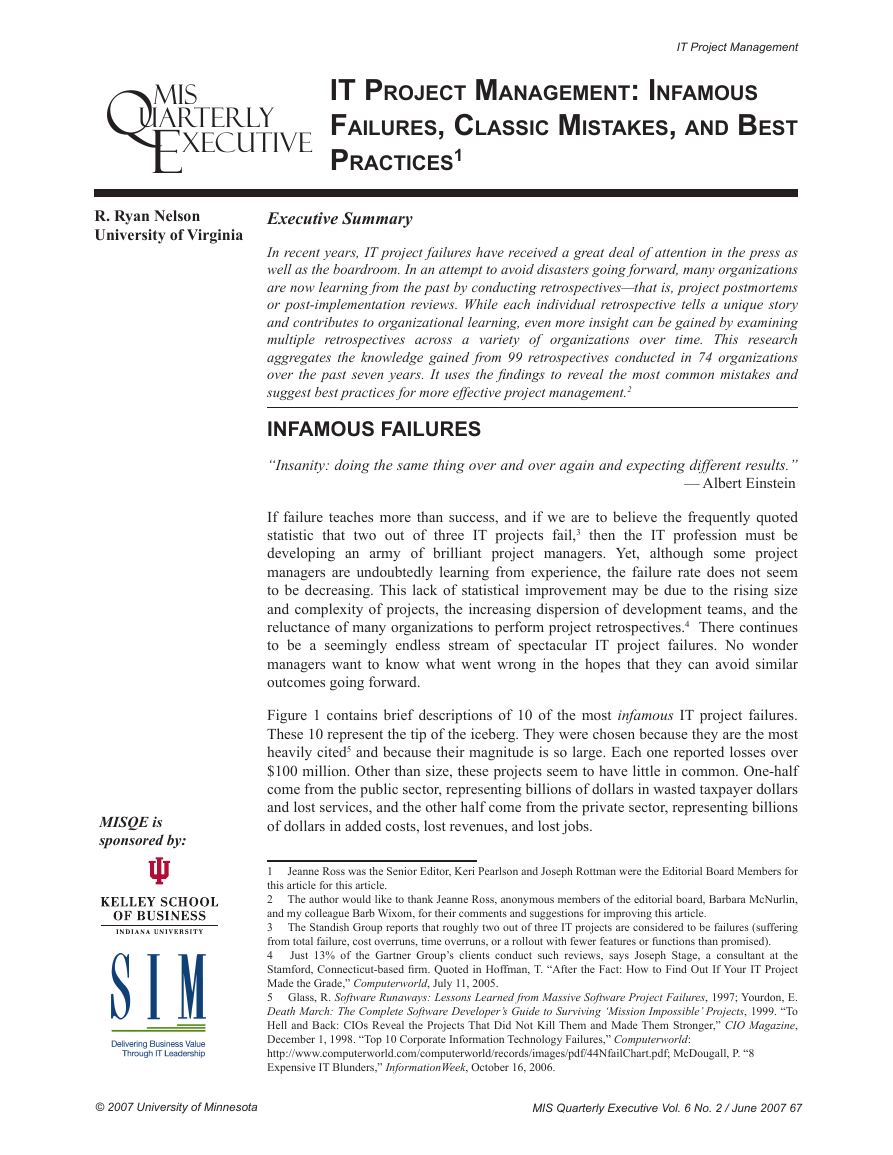
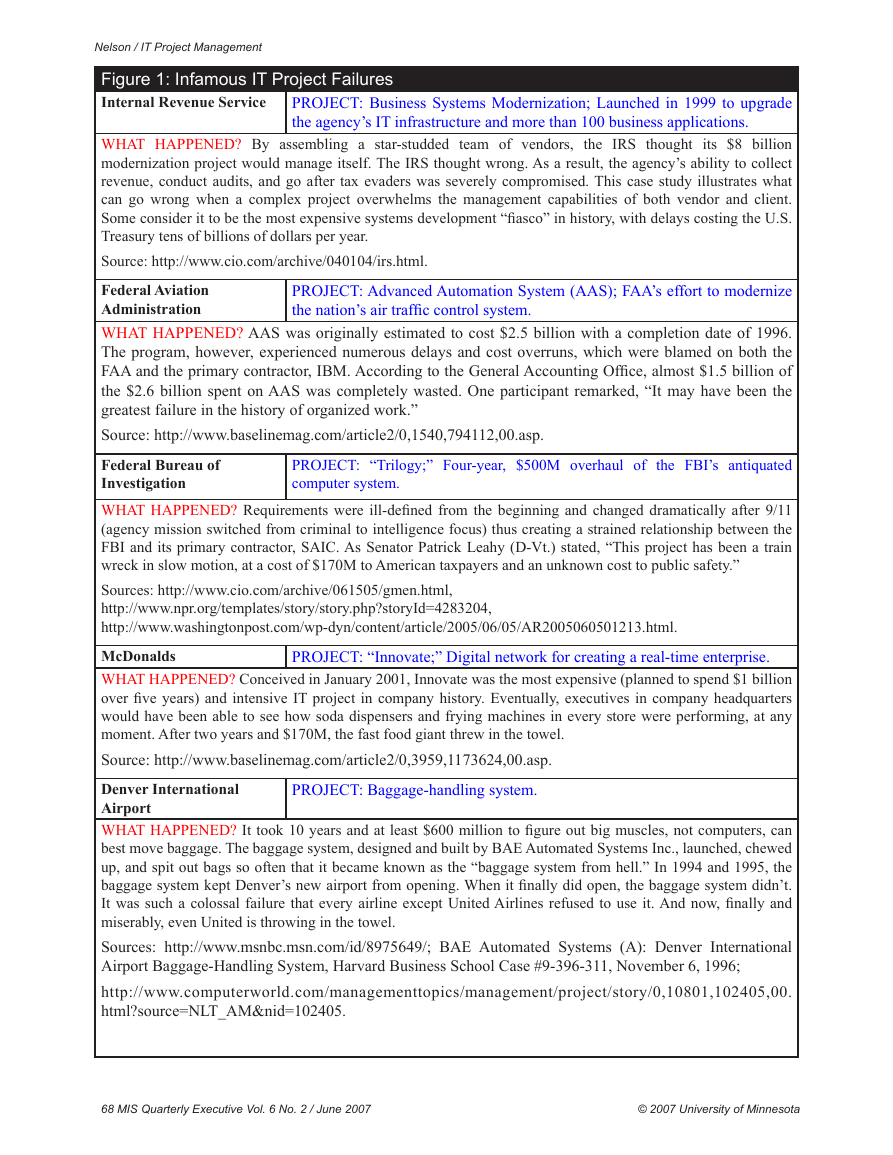
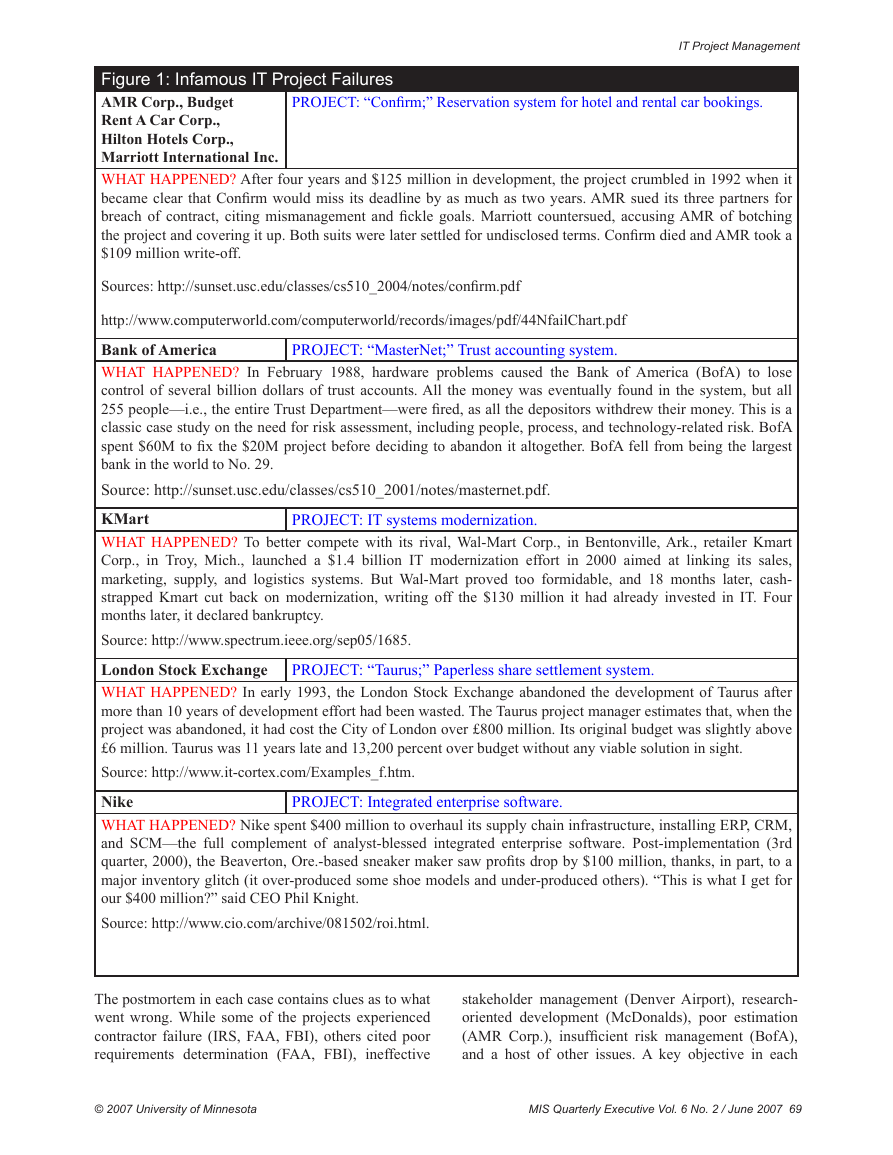
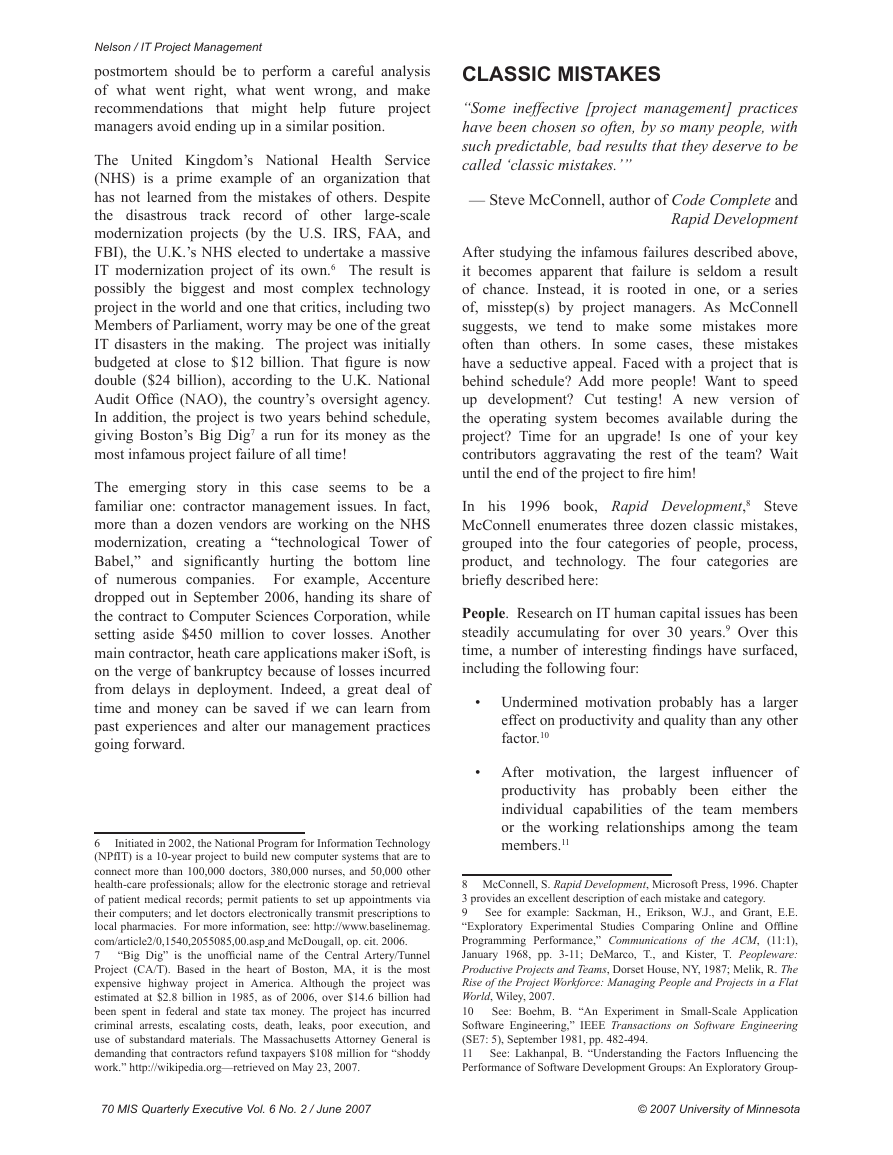

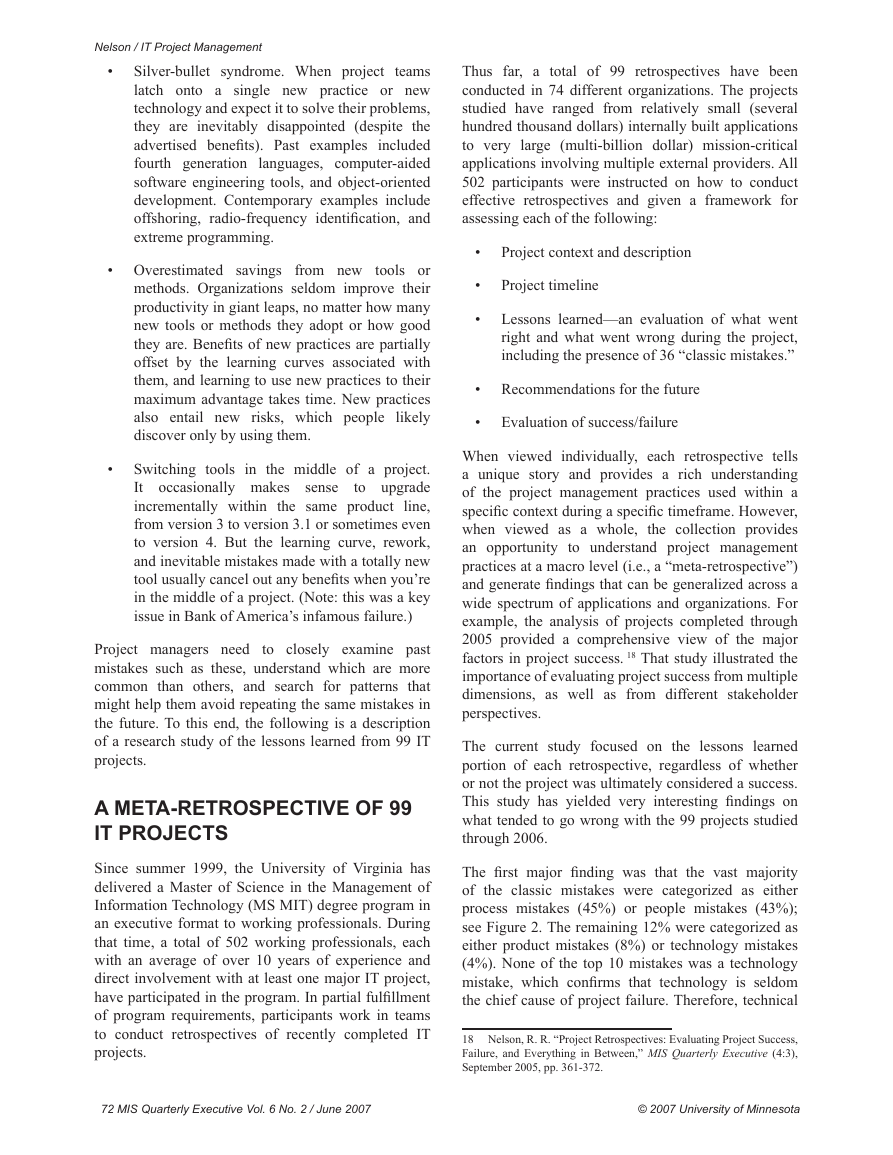
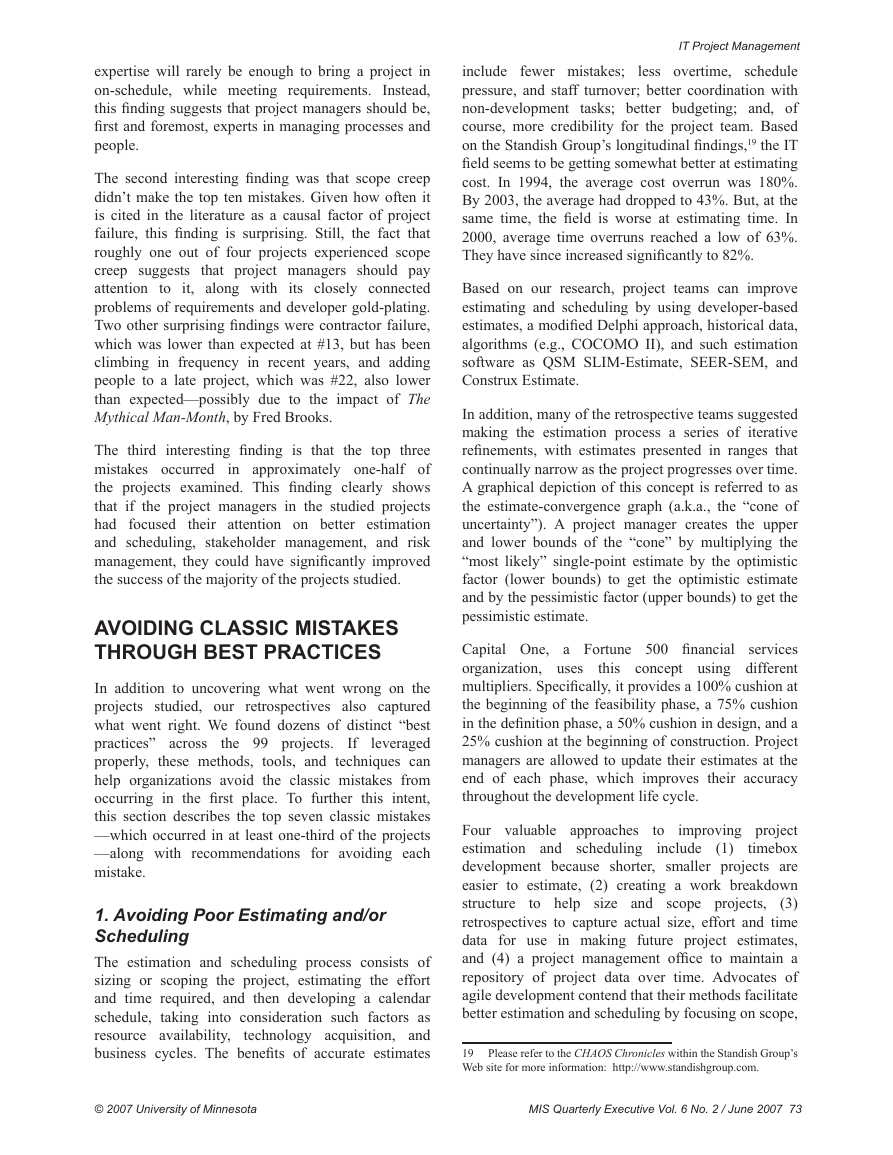
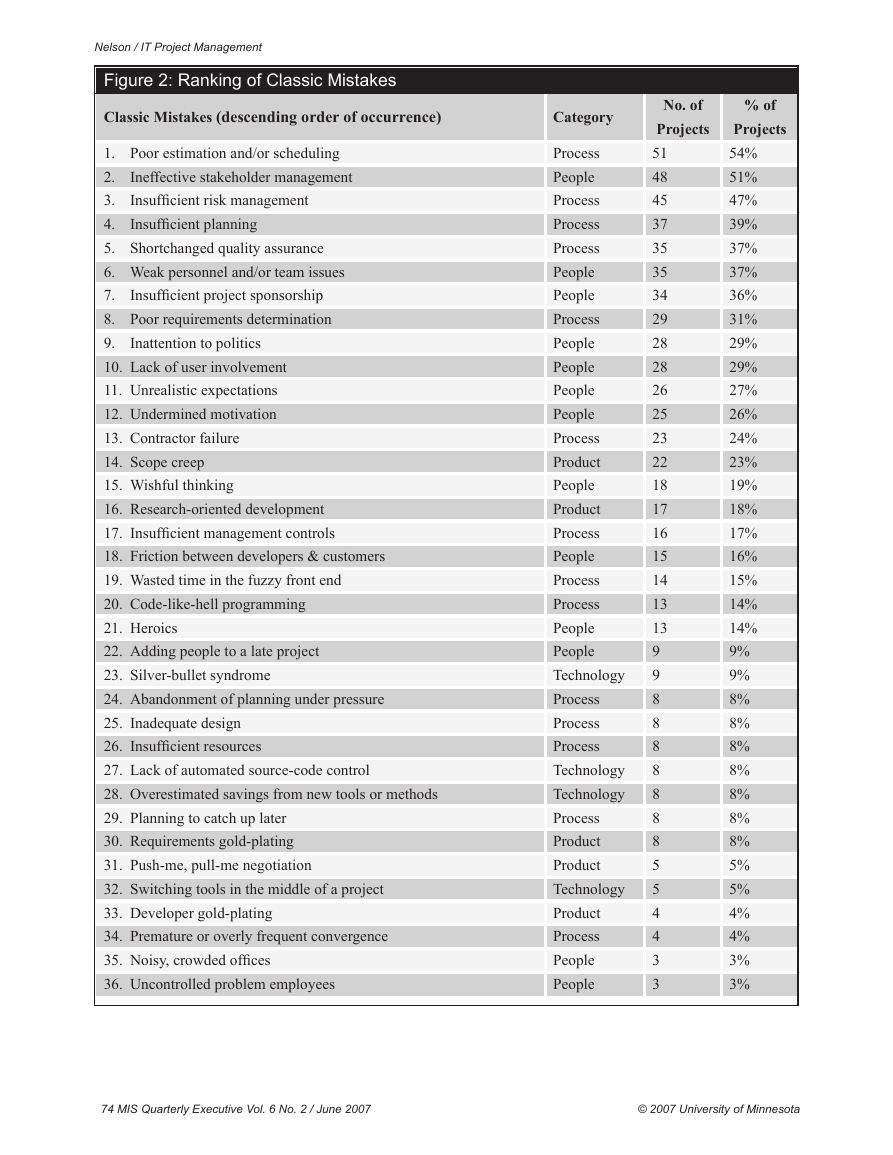








 2023年江西萍乡中考道德与法治真题及答案.doc
2023年江西萍乡中考道德与法治真题及答案.doc 2012年重庆南川中考生物真题及答案.doc
2012年重庆南川中考生物真题及答案.doc 2013年江西师范大学地理学综合及文艺理论基础考研真题.doc
2013年江西师范大学地理学综合及文艺理论基础考研真题.doc 2020年四川甘孜小升初语文真题及答案I卷.doc
2020年四川甘孜小升初语文真题及答案I卷.doc 2020年注册岩土工程师专业基础考试真题及答案.doc
2020年注册岩土工程师专业基础考试真题及答案.doc 2023-2024学年福建省厦门市九年级上学期数学月考试题及答案.doc
2023-2024学年福建省厦门市九年级上学期数学月考试题及答案.doc 2021-2022学年辽宁省沈阳市大东区九年级上学期语文期末试题及答案.doc
2021-2022学年辽宁省沈阳市大东区九年级上学期语文期末试题及答案.doc 2022-2023学年北京东城区初三第一学期物理期末试卷及答案.doc
2022-2023学年北京东城区初三第一学期物理期末试卷及答案.doc 2018上半年江西教师资格初中地理学科知识与教学能力真题及答案.doc
2018上半年江西教师资格初中地理学科知识与教学能力真题及答案.doc 2012年河北国家公务员申论考试真题及答案-省级.doc
2012年河北国家公务员申论考试真题及答案-省级.doc 2020-2021学年江苏省扬州市江都区邵樊片九年级上学期数学第一次质量检测试题及答案.doc
2020-2021学年江苏省扬州市江都区邵樊片九年级上学期数学第一次质量检测试题及答案.doc 2022下半年黑龙江教师资格证中学综合素质真题及答案.doc
2022下半年黑龙江教师资格证中学综合素质真题及答案.doc